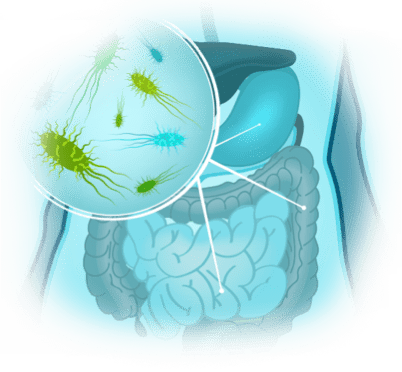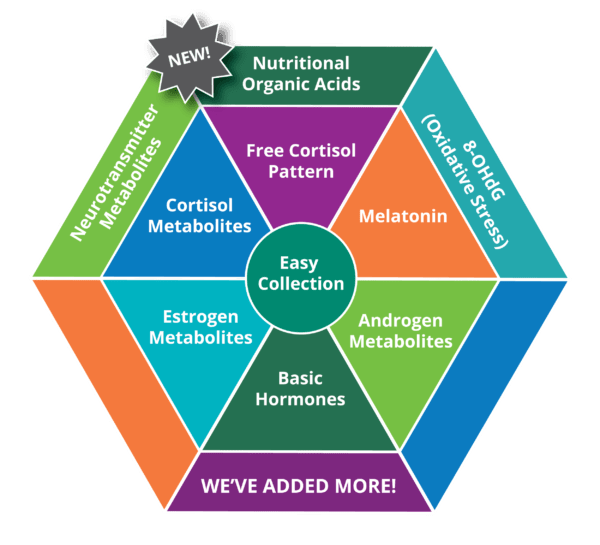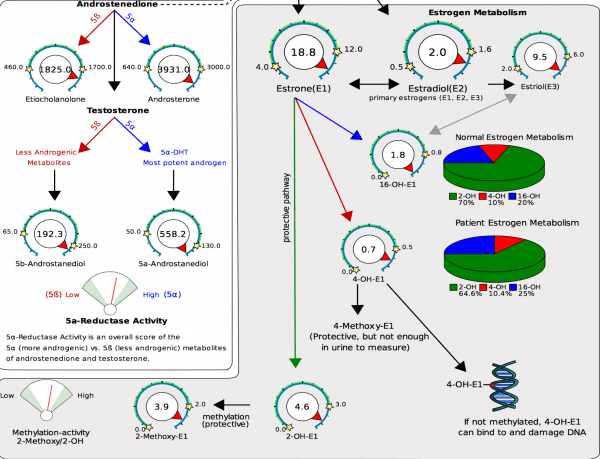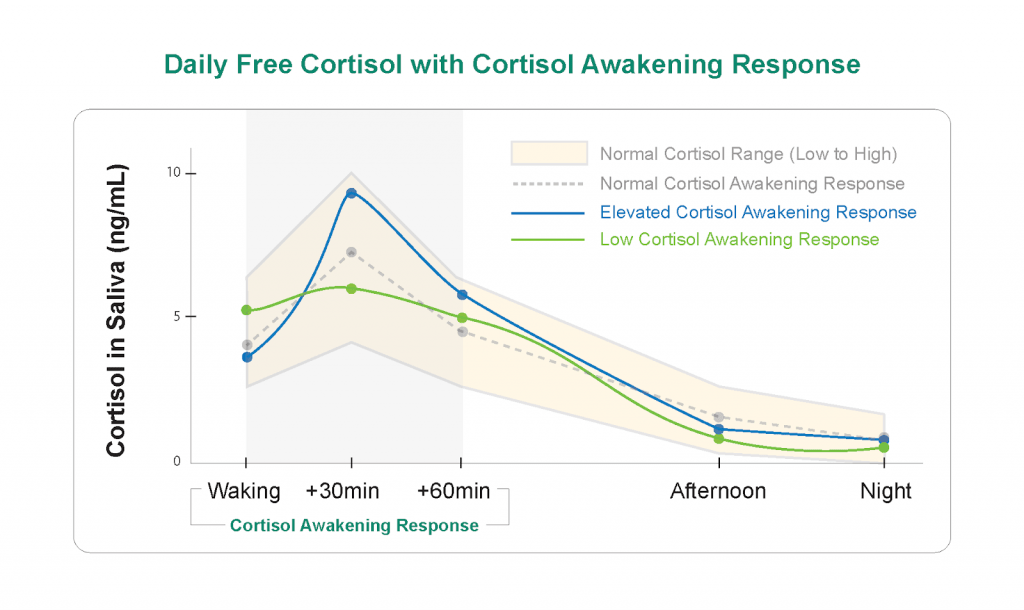Wellness Testing
Wellness Testing
Often times we need to look beyond just diet to see what’s really happening inside the body. Read on to learn more and see if you could benefit from wellness testing.
Micronutrient Analysis
Vibrant’s Micronutrient test is the only test that provides a comprehensive extracellular and intracellular assessment of the levels of the most important vitamins, minerals, antioxidants, fatty acids, and amino acids. Knowing both your extracellular and intracellular micronutrient levels are key to a thorough understanding of your nutritional requirements at a foundational level, which may contribute to your risk for disease, while simultaneously and positively impacting your overall health and well-being.
Wheat Zoomer
This test is designed to distinguish between celiac disease, non-celiac gluten sensitivity, non- gluten wheat sensitivity, and other autoimmune diseases triggered by gluten. It also includes the market’s most comprehensive biomarker panel to identify intestinal permeability (leaky gut syndrome). The Wheat Zoomer has been validated at 99% specificity and sensitivity.
Gut Zoomer
GUT BACTERIA, PARASITES, FUNGI, AND VIRUS
This test provides an unique opportunity to better understand your gut microbiome. This is a microchip-based exploration service that allows you to look at the populations of bacteria that reside in your gut. This test is based on extensive research from the NIH Human Microbiome project. The Gut Zoomer looks at specific DNA fragments that identify the unique bacteria in your sample. 16S Ribosomal Gene enables us to classify and distinguish bacteria from phylum up to sub-species level.
Food Sensitivity Testing
(96 Foods)
Food Sensitivity is your body’s response (IgG antibody reactions) to certain foods that occur hours to days after certain foods are consumed. These are also termed as delayed food reactions.
This test uses a chemiluminescent method of detecting food sensitivities on a silicon chip. This proprietary technology allows for the highest sensitivity of detection. Vibrant tests for IgG and IgA antibodies to food. These are delayed sensitivities which can take up to 72 hours to appear.
DUTCH – Dried Urine Test for Comprehensive Hormones
HOW DOES DUTCH COMPARE TO OTHER HORMONE TESTS?
This advanced hormone testing was developed to improve on available hormone testing options. DUTCH offers the most extensive profile of sex and adrenal hormones along with their metabolites. Additionally, the daily (diurnal) pattern of free cortisol is included, along with melatonin (6-OHMS), 8-OHdG, and six organic acids. This unique combination of clinical information is not available by any other method.
Weight Loss Bundle
- Food Sensitivity -IgA and IgG Antibody testing for 96 different foods
- Leptin – a hormone that helps regulate appetite by signaling hunger satisfaction (satiety). This test measures the amount of leptin in the blood to detect a deficiency that may be contributing to obesity
- Adiponectin-has been associated with insulin resistance and linked with type II diabetes, as well as glucose and lipid metabolism. Adiponectin may have relevance for energy metabolism through the regulation of fatty acid oxidation.
Vibrant’s Micronutrient test is the only test that provides a comprehensive extracellular and intracellular assessment of the levels of the most important vitamins, minerals, antioxidants, fatty acids, and amino acids. Knowing both your extracellular and intracellular micronutrient levels are key to a thorough understanding of your nutritional requirements at a foundational level, which may contribute to your risk for disease, while simultaneously and positively impacting your overall health and well-being.
EXTRACELLULAR MICRONUTRIENTS
Extracellular Micronutrients that are free-floating in your blood and exist outside the cells, determined in serum are called extracellular micronutrients.
These extracellular micronutrients are a static measure of what is in your blood at any given time. These are dependent on your short-term intake of supplements or diet and give a direct assessment of your baseline micronutrient levels.
Extracellular nutrient tests reflect a person’s diet over a relatively narrow time frame.
INTRACELLULAR MICRONUTRIENTS
Intracellular micronutrients are the micronutrients absorbed by your circulating white blood cells and red blood cells. Cellular micronutrient absorption is an important step in maintaining and promoting optimal functioning of all our cells.
It is important to understand that, even though you may be consuming an adequate or healthy diet or supplements, your cellular intake levels of those nutrients may not be sufficient and may still provide risks for deficiencies and the disorders associated with them.
Your genetics, aging, lifestyle, chronic illness, and medications all affect your cellular nutrient absorption. The intracellular portion of Vibrant’s micronutrient test takes all the above factors into consideration to identify your cellular nutrient absorption status. This test can reveal a person’s functional nutritional status over a much longer time (4-6 months) than extracellular testing.
VITAMINS
- Vitamin A
- Vitamin B1
- Vitamin B2
- Vitamin B3
- Vitamin B5
- Vitamin B6
- Vitamin B12
- Vitamin C
- Vitamin D, 25-OH
- Vitamin D3
- Vitamin K1
MINERALS
- Calcium
- Magnesium
- Manganese
- Zinc
- Copper
- Chromium
- Iron
AMINO ACIDS
- Asparagine
- Glutamine
- Serine
ANTIOXIDANTS
- Coenzyme Q10
- Cysteine
- Glutathione
- Selenium
METABOLITES
- Choline
- Inositol
- Carnitine
- MMA
- (Methyl Maloneic Acid)
INTRACELLULAR RBC
- RBC Folate
- RBC Magnesium
- RBC Iron
- RBC Omega Fatty Acids
Role of Micronutrients
Almost every physiological function in your body requires micronutrients to function optimally. Vitamin, minerals and anti-oxidants play a key role in:
- Producing and releasing energy
- Strengthening the immune system
- Reducing systemic inflammation
- Protecting against free radical damage
- Maintaining a healthy hormonal balance (i.e. thyroid, sex hormones, adrenal hormones, neurotransmitters/brain hormones, etc.)
- Maintaining insulin sensitivity
- Slowing down cellular aging
- Promoting the health of all tissues: skin, bone, brain, breast, gut, prostate, heart, muscle, organs, etc.
- Protecting against the development, progression, and recurrence of cancer
Who Should Be Tested?
This testing would be most beneficial if you:
A. Suffer From
- Chronic diseases like diabetes, cardiovascular conditions, and/or arthritis
- Skin problems
- Numbness/tingling in your hands or feet
- Weakened Immune System
- Digestive issues/disorders like celiac, wheat sensitivity, IBS, IBD, and SIBO
B. Are Experiencing
- Advanced aging
- Stress, feeling tired, or chronic fatigue
- Depression
C. Have a History of
- Long-term use of prescription medications
- Poor diet
- Obesity
D. Are Someone who is a
- Athletic competitor/exercise regularly
- Vegan or Vegetarian
This test is designed to distinguish between celiac disease, non-celiac gluten sensitivity, non- gluten wheat sensitivity, and other autoimmune diseases triggered by gluten. It also includes the market’s most comprehensive biomarker panel to identify intestinal permeability (leaky gut syndrome). The Wheat Zoomer has been validated at 99% specificity and sensitivity.
What is wheat/gluten sensitivity?
Wheat and gluten sensitivities are immune responses in which, upon ingestion of wheat or gluten (from gluten-containing grains), antibodies against the protein component of these grains are generated. Gluten sensitivity is only a subset of a much larger group of wheat/gluten-related disorders.
Symptoms and conditions associated with wheat/gluten sensitivity:
- Digestive discomfort/IBS
- Low vitamin D levels
- Difficulty concentrating or “brain fog”
- Low energy levels/fatigue
- Leaky gut syndrome
- Skin inflammation (eczema, dermatitis)
- Chronic headaches
- Weight gain/weight loss
- Joint pain or numbness in the legs, arms or fingers.
The Wheat Zoomer allows detection of protein antibodies associated with wheat and gluten sensitivities for information to reduce, monitor and manage the inflammatory effects of those sensitivities.
Wheat Zoomer Intestinal Antibody Detection Includes:
- All known deamidated gliadins
- Alpha, alpha-beta, gamma and omega gliadin
- HMW and LMW glutenin family
- Zonulin protein and actin
- tTG-DGP Fusion Peptides
- Wheat germ agglutinin (WGA)
- Differential transglutaminase: 2, 3 and 6
- Non-gluten wheat proteins
- Farinins
- Globulins
- Serpins
- Amylase/Protease Inhibitors
- Total IgA and IgG
- Plus additional antibodies tested…
Wheat Zoomer Intestinal Permeability Panel includes:
- Lipopolysaccharide IgG/IgM/IgA
- Zonulin
- Anti-Actin IgG/IgA
- Anti-Zonulin IgG/IgA
GUT BACTERIA, PARASITES, FUNGI, AND VIRUS
This test provides an unique opportunity to better understand your gut microbiome. This is a microchip-based exploration service that allows you to look at the populations of bacteria that reside in your gut. This test is based on extensive research from the NIH Human Microbiome project. The Gut Zoomer looks at specific DNA fragments that identify the unique bacteria in your sample. 16S Ribosomal Gene enables us to classify and distinguish bacteria from phylum up to sub-species level.

WHAT IS THE GUT MICROBIOME?
The gut microbiome, which hosts more than 1000 bacterial species that encode about 5 million genes, performs many of the important functions like aid in the digestion of foods, immune system development, vitamin synthesis, ion absorption, salvage of energy, which our body cannot perform by itself. As its name states, gut microbiome is harbored in the intestine, one of the main areas in our bodies that comes into contact with the external environment (other examples are the skin and the lungs). Alterations in the composition of the gut microbiome could lead to a bacterial imbalance which has been related to an increasing number of intestinal and extra-intestinal diseases. Some of the factors that lead to such imbalances include:
- Diet high in refined carbohydrates
- Proinflammatory food choices
- Excessive protein intake
- Lack of fiber
- Stress
- Antibiotic use
- Foreign travel
- Sedentary lifestyle
- Household environment
GUT MICROBIOME IMBALANCE EFFECTS
Imbalances in your gut microbiome may lead to the following symptoms/effects:
- Gastrointestinal symptoms / IBS
- Autoimmune disease
- Nutritional (or vitamin) deficiencies
- Skin conditions
- Autism Spectrum / ADH
- Food intolerances
- Inflammation or joint pain
- Low energy levels / fatigue
GUT MICROBIOME IMBALANCE TESTING
Of all the bacterial species, only about a 100 types have potential health outcomes based on existing scientific studies and peer-reviewed journals.
It is important to know the abundance of these bacteria to make healthy lifestyle decisions. Some of these include:
BACTERIA
- Bifidobacterium
- Propionibacterium
- Lactobacillus
- Prevotella
- Roseburia
- Clostridium
- Faecalibacterium prausnitzii
- Desulfovibrio
- Escherichia coli
- Akkermansia
- Methanobacteriales
- Eubacterium and many more…
PATHOGENIC BACTERIA
- Shigella
- Helicobacter pylori
- Salmonella sp
- Clostridium difficile
- Campylobacter
- Listeria sp
- Yersinia
- Klebsiella
- Edwardsiella tarda
- Escherichia coli O157
- Enterotoxigenic Escherichia coli
BACTERIA
- Cryptosporidium
- Entamoeba
- Giardia
- Candida Albicans (Fungal yeast)
The Gut Zoomer performs the most comprehensive analysis available of your microbial profile from a simple and easy to use feces collection kit and provides you with an actionable report that includes potential risks for:
- Intestinal Permeability (SCFA producing Bacteria and Tight Junction Integrity)
- Intestinal Disorders (IBD related bacteria)
- Heart Health (Lipid Influencing and TMAO bacteria)
- Autoimmune Disorders (Celiac, Crohn’s etc)
- Metabolic Disorders (Obesity, Diabetes)
- Nutrition (Vitamin Production, Oxalate Metabolism)
- Intestinal Parasites – Cryptosporidium, Entamoeba and Giardia
- Fungal yeast – Candida Albicans
Food Sensitivity is your body’s response (IgG antibody reactions) to certain foods that occur hours to days after certain foods are consumed. These are also termed as delayed food reactions.
This test uses a chemiluminescent method of detecting food sensitivities on a silicon chip. This proprietary technology allows for the highest sensitivity of detection. Vibrant tests for IgG and IgA antibodies to food. These are delayed sensitivities which can take up to 72 hours to appear.
- IgG antibodies are the most common form of immunologic mediated food responses. Most food sensitivity testing only include an IgG response.
- IgA antibodies provide protection from mucosal damage. Elevated levels may indicate mucosal damage.
- If IgG reactions are negative and you are still symptomatic, IgA reactivity may help provide answers.
This test identifies both IgG and IgA reactivity to 96 of the most commonly consumed foods including dairy, meat, seafood, fruits, vegetables, grains, legumes, nuts, nightshades, and more.
SYMPTOMS TO CONSIDER FOOD SENSITIVITY TESTING
- Abdominal pain
- Gas
- Bloating
- Nausea and vomiting
- Skin itchiness and redness
- Rashes like eczema
- Bronchitis and asthma symptoms
- Musculoskeletal joint pain
- Muscle stiffness and swelling
- Fever
- Fatigue
- Sweating and feeling weak
Undetected food sensitivities could lead to symptoms and systemic changes that are associated with certain conditions/illness:
DIGESTIVE DISORDERS
Conditions like irritable bowel syndrome (IBS) and Crohn’s disease have been linked to IgG food reactions. Research has shown that elimination of IgG reactive foods can alleviate IBS symptoms.
MIGRAINES
A 2007 research study found that 43/65 patients with migraine headaches had complete remission of headaches after one month of eliminating reactive foods. Another study in 2010 found a significant reduction in the number of headache days and migraine attacks with elimination of reactive foods.
MOOD/ATTENTION DEFICIT DISORDERS
Deposition of antibody-antigen complexes in nervous system tissues may contribute to hyperactivity, depression, anxiety, inability to concentrate and other mood disorders. There is some evidence that eliminating IgG food antigens improve attentiveness in children.
WEIGHT GAIN
Antibody-antigen complexes in tissue cause inflammation, which leads to fluid retention and weight gain. To fight inflammation, the body releases a chemical called ghrelin, which also happens to be an appetite stimulant. Thus, IgG food reactions may contribute to weight gain in two ways: fluid retention and increased appetite.
WHY TEST FOR FOOD SENSITIVITIES?
Since food sensitivities are delayed reactions, testing is the only way to determine which foods are responsible for the reaction. IgG reactions frequently occur to commonly consumed foods such as dairy, wheat, eggs, yeast, pork and soy.
(removing suspect foods for a period of time and then reintroduce and check for reactions) are difficult to follow and can take months to complete.
Can be implemented working with our team of clinical dietitians.
HOW DOES DUTCH COMPARE TO OTHER HORMONE TESTS?
This advanced hormone testing was developed to improve on available hormone testing options. DUTCH offers the most extensive profile of sex and adrenal hormones along with their metabolites. Additionally, the daily (diurnal) pattern of free cortisol is included, along with melatonin (6-OHMS), 8-OHdG, and six organic acids. This unique combination of clinical information is not available by any other method.

DUTCH COMPLETE
- Analysis of 35 different hormones: estrogen, progesterone, testosterone, DHEA-S, and cortisol along with their metabolites
- Daily free cortisol patterns to provide insight into adrenal insufficiency or symptoms of chronic stress
- Graphical representation of results and embedded video tutorials to assist in the hormone assessment to share with your medical provider
- DUTCH OATs: Oxidative stress marker – 8-Hydroxy-2-deoxyguanosine (8-OHdG), melatonin (6-OHMS), and six organic acid tests (OATs) including markers for vitamin B12 (methylmalonate), vitamin B6 (xanthurenate), glutathione (pyroglutamate), dopamine (homovanillate), norepinephrine/epinephrine (vanilmandelate), and serotonin (5-hydroxyindoleacetate)
DUTCH PLUS
- The DUTCH Plus takes hormone testing to a whole new level. In addition to sex hormones and their metabolites, the DUTCH Complete looks at the overall diurnal pattern of free cortisol, and the total and distribution of cortisol metabolites. The DUTCH Plus adds the Cortisol Awakening Response (CAR) to bring another important piece of the HPA-axis into focus
- Analysis of 35 different hormones: estrogen, progesterone, testosterone, DHEA-S, and cortisol along with their metabolites, plus the cortisol awakening response (CAR)
- Graphical representation of results and embedded video tutorials to assist in the hormone assessment to share with your medical provider
- DUTCH OATs: Melatonin (6OHMS), 8-Hydroxy-2-deoxyguanosine (8-OHdG), and six organic acid tests (OATs) including markers for vitamin B12 (methylmalonate), vitamin B6 (xanthurenate), glutathione (pyroglutamate), dopamine (homovanillate), norepinephrine/epinephrine (vanilmandelate), and serotonin (5-hydroxyindoleacetate)
DUTCH CYCLE MAPPING (FEMALE ONLY)
- Nine (9) targeted estrogen and progesterone measurements taken throughout the cycle to characterize the follicular, ovulatory and luteal phases
- Graphical representation of results and embedded video tutorials to assist in the hormone test analysis to share with your medical provider
DUTCH CYCLE MAPPING & COMPLETE BUNDLE (FEMALE ONLY)
- Analysis of 35 different hormones: estrogen, progesterone, testosterone, DHEA, and cortisol along with their metabolites
- Nine targeted estrogen and progesterone measurements throughout the cycle to characterize the follicular, ovulatory and luteal phases
- Graphical representation of results and embedded video tutorials to assist in the hormone test analysis to share with your medical provider
- DUTCH OATs: Oxidative Stress Marker – 8-Hydroxy-2-deoxyguanosine (8-OHdG), melatonin (6OHMS), and six organic acid tests (OATs) including markers for vitamin B12 (methylmalonate), vitamin B6 (xanthurenate), glutathione (pyroglutamate), dopamine (homovanillate), norepinephrine/epinephrine (vanilmandelate), and serotonin (5-hydroxyindoleacetate)
CORTISOL AWAKENING RESPONSE
- Analysis of cortisol awakening response (CAR) from cortisone (5) and cortisol (5)
- Graphical representation of results
- Provider notes with specific additional information created specifically for the patient
DUTCH SEX HORMONE METABOLITES
- Extensive Estrogen Metabolites: E1, E2, E3, 2-OH-E1, 4-OH-E1, 16-OH-E1, 2-Methoxy-E1, 2-Methoxy-E2, 2-OH-E2, 4-OH-E2.
- Extensive Androgen Metabolites: Testosterone, DHEAs, DHT, and more (7)
- Progesterone Metabolites: b-Pregnanediol, a-Pregnanediol (2)
- Graphical representation of results and embedded video tutorials to assist in the hormone assessment to share with your medical provider
DUTCH ADRENAL
- Daily free cortisol pattern (4)
- Daily free cortisone pattern (4)
- Cortisol metabolites (a-THF, b-THF)
- Cortisone metabolites (b-THE)
- DHEAs

DUTCH VS. SALIVA TESTING
While the free cortisol pattern in saliva has clinical value, there is a significant missing piece to surveying a patient’s HPA-Axis function with saliva testing – measuring cortisol metabolites. To properly characterize a patient’s cortisol status, free and metabolized cortisol should be measured to avoid misleading results when cortisol clearance is abnormally high or low. Likewise with sex hormones, measuring estrogen and androgen metabolites gives a fuller picture for more precise clinical diagnosis of hormonal imbalances and HRT monitoring.
DUTCH VS. SERUM TESTING
While the most universally accepted testing method (due to the availability of FDA-cleared analyzers that are reliable and inexpensive), serum testing is lacking in some areas. Adrenal hormones cannot be effectively tested in serum because free cortisol cannot be tested throughout the day. There is also a lack of extensive metabolite testing (especially for cortisol and estrogens).
DUTCH VS. 24-HOUR URINE TESTING
There are two primary drawbacks to 24-hour urine testing of hormones. First, the collection is cumbersome, and as many as 40% of those who collect, do so in error (Tanaka, 2002). Secondly, dysfunction in the diurnal pattern of cortisol cannot be ascertained from a 24-hour collection. Some providers add saliva for daily free cortisol. DUTCH eliminates the need for two tests.

WHAT CAN THE DUTCH PLUS™TELL US THAT THE DUTCH COMPLETE CANNOT?
Even though a patient may have “normal” free cortisol levels throughout the day, that doesn’t always mean everything is functioning properly. The graph below shows two good examples. A blunted or exaggerated Cortisol Awakening Response (CAR) can appear, even when single samples return “normal” results. The HPA axis might not be appropriately responding when faced with a stressor, even when cortisol levels are fluctuating nicely throughout the day. The “stress” of waking allows us to test the HPA axis in a way that has been independently correlated to clinical outcomes and cannot be assessed by other cortisol tests on the market.
- Food Sensitivity – IgA and IgG Antibody testing for 96 different foods
- Leptin – a hormone that helps regulate appetite by signaling hunger satisfaction (satiety). This test measures the amount of leptin in the blood to detect a deficiency that may be contributing to obesity
- Adiponectin – has been associated with insulin resistance and linked with type II diabetes, as well as glucose and lipid metabolism. Adiponectin may have relevance for energy metabolism through the regulation of fatty acid oxidation.
Hormones
- Estradiol
- FSH
- DHEA-S
- LH
- Cortisol
- Testosterone, Total
- Testosterone, Free
- Progesterone
- Parathyroid Hormone
- Prolactin
- DHT
- Pregnenolone
Micronutrients
Vitamins
- Vitamin A
- Vitamin B1
- Vitamin B2
- Vitamin B3
- Vitamin B5
- Vitamin B6
- Vitamin C
- Vitamin D3
- Vitamin D, 25-OH
- Vitamin E
- Vitamin K1
- Vitamin K2
- Folate
Antioxidants
- CoQ10
- Cysteine
- Selenium
Amino Acids
- Asparginine
- Glutamine
- Serine
- Arginine
- Citrulline
- Isoleucine
- Valine
- Leucine
Electrolytes
- Sodium
- Potassium
Metabolites
- Choline
- Inositol
- Carnitine
- MMA
Minerals
- Calcium
- Manganese
- Magnesium
- Zinc
- Copper
- Chromium
- Iron
Omega Fatty Acids
- Omega 3
- Insulin
- HBA1C
- T3
- T4
- TSH



